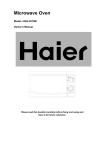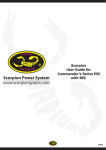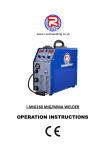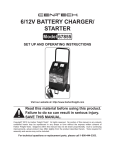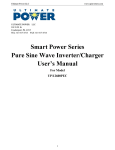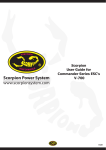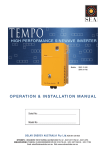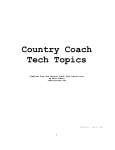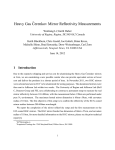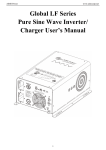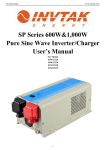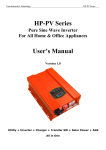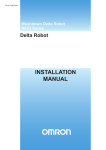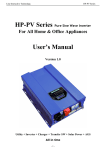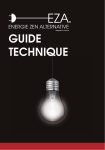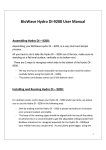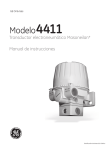Download 1K-3K User Manual
Transcript
UP Series Pure Sine Wave Inverter & Charger User Manual Models: UP12/1000PCUL, *UP12/1500PCUL, UP12/2000PCUL, UP12/3000PCUL (*UP12/1500PCUL is not UL Listed) 202 North West Street Coudersport, PA 16915 Phone: 610 317-8513 Fax: 610 317-8514 E-Mail: [email protected] Web: www.upinverters.com TABLE OF CONTENTS Description Page # Important Safety Information …………………………. 3 1.1 General Safety Precautions ……………………………... 3 1.2 Precautions When Working with Batteries …………….. 3 Introduction ……………………………………………… 4 2.1 General Information ………………………………………. 4 2.2 Application ………………………………………………… 4 2.3 Mechanical Drawing ……………………………………… 5 2.4 Features …………………………………………………… 6 Electrical Performance ………………………………… 6 Section # Section 1 Section 2 Section 3 3.1 Invert ……………………………………………………… 6 3.2 AC Charger ………………………………………………. 6-9 3.3 AC Transfer ………………………………………………. 9 3.4 Auto Frequency Adjust ………………………………….. 10 3.5 Power Saver ……………………………………………… 10 3.6 Protections ……………………………………………….. 11 3.7 Remote Control ………………………………………….. 11-12 3.8 LED Indicator ……………………………………………… 13 3.9 Audible Alarm ……………………………………………... 13 3.10 FAN Operation ……………………………………………. 13-14 Section 4 Installation ………………………………………………... 14 4.1 Location ……………………………………………………. 14 4.2 DC Wiring …………………………………………………. 14-15 4.3 AC Wiring …………………………………………………. 15 4.4 Grounding …………………………………………………. 15 4.5 Install Flange ……………………………………………… 16 Section 5 Troubleshooting Guide ………………………………… 17-19 Section 6 Limited Warranty Plan………………………………….. 19 Appendix 1 Appendix 1 ……………………………………………….. 20-21 Notes Notes ………………………………………………………. 21-24 -2- 1. Important Safety Information WARNING! Before using the Inverter, you need to read and save the safety instructions. 1.1 General Safety Precautions 1.1.1. Do not expose the Inverter to rain, snow, spray, bilge or dust. To reduce risk of hazard, do not cover or obstruct the ventilation openings. Do not install the Inverter in a zero-clearance compartment. Overheating may result. Allow at least 30CM (11.81 inches) of clearance around the inverter for air flow. Make sure that the air can circulate freely around the unit. A minimum air flow of 145CFM is required. 1.1.2. To avoid a risk of fire and electronic shock; make sure that existing wiring is in good electrical condition; and that wire size is not undersized. Do not operate the Inverter with damaged or substandard wiring. 1.1.3. This equipment contains components which can produce arcs or sparks. To prevent fire or explosion do not install in compartments containing batteries or flammable materials or in locations which require ignition protected equipment. This includes any space containing gasoline-powered machinery, fuel tanks, or joints, fittings, or other connection between components of the fuel system. See Warranty for instructions on obtaining service. 1.1.4. Do not disassemble the Inverter/Charger. It contains no user serviceable parts. Attempting to service the Inverter/Charger yourself may result in a risk of electrical shock or fire. Internal capacitors remain charged after all power is disconnected. 1.1.5. To reduce the risk of electrical shock, disconnect both AC and DC power from the Inverter/Charger before attempting any maintenance or cleaning. Turning off controls will not reduce this risk CAUTION: Equipment damage The output side of the inverter’s AC wiring should at no time be connected to public power or a generator. This condition is far worse than a short circuit. If the unit survives this condition, it will shut down until corrections are made. Installation should ensure that the inverter’s AC output is, at no time, connected to its AC input. Warning: Limitations on Use SPECIFICALLY, PLEASE NOTE THAT THE UP SERIES INVERTER/CHARGER SHOULD NOT BE USED IN CONNECTION WITH LIFE SUPPORT SYSTEMS OR OTHER MEDICAL EQUIPMENT OR DEVICES. 1.2 Precautions When Working with Batteries 1.2.1. If battery acid contacts skin or clothing, wash immediately with soap and water. If acid enters eye, immediately flood eye with running cold water for at least 20 minutes and get medical attention immediately 1.2.2. Never smoke or allow a spark or flame in vicinity of battery or engine 1.2.3. Do not drop a metal tool on the battery. The resulting spark or short-circuit on the battery of other electrical part may cause an explosion 1.2.4. Remove personal metal items such as rings, bracelets, necklaces, and watches when working with a lead-acid battery. A lead-acid battery produces a short circuit current high enough to weld a ring or the like to metal causing a severe burn 1.2.5. To reduce the risk of injury, charge only rechargeable batteries such as deep-cycle lead acid, lead antimony, lead calcium gel cell, absorbed mat, and NiCad/NiFe or Lithium battery. Other types of batteries may burst, causing personal injury and damage -3- 2. Introduction 2.1 General Information UP Series Pure Sine Wave Inverter is a combination of an inverter, battery charger and AC auto-transfer switch into one complete system with a peak conversion efficiency of 85%. It is packed with unique features and it is one of the most advanced inverter/chargers in the market today. It features power factor corrected, sophisticated multi-stage charging and pure sine wave output with unprecedentedly high surge capability to meet demanding power needs of inductive loads without endangering the equipment. When the utility AC power cuts off or falls out of acceptable range, the transfer relay is de-energized and the load is automatically transferred to the Inverter output. Once the qualified AC utility is restored, the relay is energized and the load is automatically reconnected to AC utility The UP Series Inverter is equipped with a powerful charger of up to 130Amps (for 3KW one). The overload capacity is 300% of continuous output for up to 20 seconds to reliably support tools and equipment longer To get the most out of the power inverter, it must be installed, used and maintained properly. Please read the instructions in this manual before installing and operating. 2.2 Applications (examples, not limited to list below) Power Tools: circular saws, drills, grinders, sanders, buffers, weed/hedge trimmers and air compressors Office Equipment: computers, printers, monitors, facsimile machines and scanners Household Items: vacuum cleaners, fans, fluorescent and incandescent lights, shavers and sewing machines Kitchen appliances: coffee makers, blenders, ice markers and toasters Industrial Lamps: metal halide lamp, high pressure sodium lamp Home Entertainment Electronics: television, VCRs, video games consoles, stereo equipment, musical instruments and satellite TV equipment -4- 2.3 Mechanical Drawing Models: UP-12/1000PCUL, *UP-12/1500PCUL, UP-12/2000PCUL, UP-12/3000PCUL (*UP12/1500PCUL is not UL Listed) Inverter physical description 1. DC input Openings Positive (+) & Negative (-): Allows the DC input 2. RJ11 Remote Panel Port: Connects to the remote control panel through the flat grey extension cable 3. DC Cooling Fan 4. Bonding Lug: Connects to the ground system (vehicle chassis or earth ground) 5. Circuit Breaker: Protects the inverter’s internal circuitry from shorted AC loads or overload situations 6. GFCI 7. Field Wiring Compartment: Provides access to the AC input and output hardwire leads and the 12Vdc remote switch -5- 2.4 Features 2.4.1 High overload ability up to 300% rated power (20 sec) 2.4.2 Low quiescent current, low power “Power Saving Mode” to conserve energy 2.4.3 4-step intelligent battery charging, PFC (Power Factor Correction) for charger 2.4.4 8 pre set battery type selector plus De-sulfation for totally flat batteries 2.4.5 Powerful charge rate up to 130Amp, selectable from 0%-100% 2.4.6 10ms typical transfer time between battery and AC, guarantees power continuity 2.4.7 Smart remote control 2.4.8 15s delay before transfer when AC resumes, extra protection for loads when used with generator 2.4.9 Allows start up and through power with depleted batteries 2.4.10 30A through current ability 2.4.11 Multiple speed controlled cooling fan 2.4.12 Extensive protections against various harsh situations 3 Electrical Performances 3.1 Invert Topology The UP inverter/charger is built according to the following topology. Invert: Full Bridge Topology. Charge: Isolate Boost Topology Because of high efficiency MOSFETs and 16bit, 4.9MHZ microprocessor and heavy transformers, it outputs PURE SINE WAVE AC with an average THD of 15% (min 5%, max 25%) depending of load connected and battery voltage. The peak efficiency of UP Series is 85%. Overload Capacity The UP Series inverters have different overload capacities, making it ideal to handle demanding loads. a. For 110%<Load<125% (±10%), no audible alarm in 14 minutes, beeps 0.5s every 1s in the 15th minute, and Fault(Turn off) after the 15th minute b. For 125%<Load<150% (±10%), beeps 0.5s every 1s and Fault (Turn off) after the 1 minute c. For 300%≧Load>150% (±10%), beeps 0.5s every 1s and Fault (Turn off) after 20s. Caution: After the inverter is switched on, it takes a finite time for it to self-diagnoses and get ready to deliver full power. Hence, always switch on the load(s) after a few seconds of switching on the inverter. Avoid switching on the inverter with the load already switched on. This may prematurely trigger the overload protection. When a load is switched on, it may require initial higher power surge to start. Hence, if multiple loads are being powered, they should be switched on one by one so that the inverter is not overloaded by the higher starting surge if all the loads are switched on at once. 3.2 AC Charger UP Series is equipped with an active PFC (Power Factor Corrected) multistage battery charger. The PFC feature is used to control the amount of power used to charge the batteries in order to obtain a power factor as close as possible to 1. Unlike other inverters whose max charging current decreases according to the input AC voltage, UP Series charger is able to output max current as long as input AC voltage is in the range of 95-127VAC, and AC freq is in the range of 58-64Hz. The UP Series inverter possesses a strong charging current of 130Amp (for 3KW 12Vdc model), and the max charge current can be adjusted from 0%-100% via a liner switch to the right of the battery type selector. This will be helpful if you are using our powerful charger on a small capacity battery bank. Choosing “0” in the battery type selector will disable charging function. -6- Inverter Status Panel (on top of the inverter) There are 3 main charging processes: Bulk Charging: This is the initial stage of charging. While Bulk Charging, the charger supplies the battery with controlled constant current. The charger will remain in Bulk charge until the Absorption charge voltage (determined by the Battery Type selection) is achieved. Software timer will measure the time from A/C start until the battery charger reaches 0.3V below the boost voltage, then take this time asT0 and T0×10 = T1 Absorb Charging: This is the second charging stage and begins after the absorb voltage has been reached. Absorb Charging provides the batteries with a constant voltage and reduces the DC charging current in order to maintain the absorb voltage setting. In this period, the inverter will start a T1 timer; the charger will keep the boost voltage in Boost CV mode until the T1 timer has run out. Then drop the voltage down to the float voltage. The timer has a minimum time of 1 hour and a maximum time of 12 hours Float Charging: The third charging stage occurs at the end of the Absorb Charging time. While Float charging, the charge voltage is reduced to the fl oat charge voltage (determined by the Battery Type selection*). In this stage, the batteries are kept fully charged and ready if needed by the inverter. If the A/C is reconnected or the battery voltage drops below 12Vdc, the charger will reset the cycle above. If the charge maintains the float state for 10 days, the charger will deliberately reset the cycle to protect the battery. -7- Battery type selector Switch Settings 0 1 2 3 4 5 6 7 8 9 Description Boost / Vdc Charger Off Gel USA AGM 1 LiFePO4 Sealed lead acid Gel EURO Open lead acid Calcium De-sulphation Not used Float / Vdc 14.0 13.7 14.1 13.4 14.6 13.7 14.4 13.6 14.4 13.8 14.8 13.3 15.1 13.6 15.5 (4 Hours then Off) 12Vdc Mode De-sulphation The de-sulphation cycle on switch position 8 is marked in red because this is a very dangerous setting if you do not know what you are doing. Before ever attempting to use this cycle you must clearly understand what it does and when and how you would use it. What causes sulphation? This can occur with infrequent use of the batteries, or if the batteries have been left discharged so low that they will not accept a charge. This cycle is a very high voltage charge cycle designed to try to break down the sulphated crust that is preventing the plates from taking a charge and thus allow the plates to clean up and accept a charge once again. -8- Charging depleted batteries The UP Series inverter allows start up and through power with depleted batteries. For 12VDC model, after the battery voltage goes below 10V, if the switch is still(and always) kept in "ON" position, the inverter is always connected with battery, and the battery voltage doesn’t drop below 2V, the inverter will be able to charge the battery once qualified AC inputs. Before the battery voltage going below 9VDC, the charging can activated when the switch is turned to “Off”, then to “ON”. When the voltage goes below 9VDC, and you accidently turn the switch to OFF or disconnect the inverter from battery, the inverter will not be able to charge the battery once again, because the CPU lose memory during this process. Start up without battery function can be customized upon request. Charging Current for each model Model UP12/1000PCUL UP12/1500PCUL UP12/2000PCUL UP12/3000PCUL Current 30+/-5A 45+/-5A 95+/-5A 125+/-5A The charging capacity will go to peak in around 3 seconds; this may probably cause a generator to drop frequency, making inverter transfer to battery mode. It is suggested to gradually put charging load on the generator by switching the charging switch from min to max, together with the 15s switch delay, our inverter gives the generator enough time to spin up. Caution: Please turn the charge current control switch gently to avoid breakage due to over-turning 3.3 AC Transfer While in the Standby Mode, the AC input is continually monitored. Whenever AC power falls below the VAC Trip voltage (90 VAC, default setting), the inverter automatically transfers back to the Invert Mode with minimum interruption to your appliances - as long as the inverter is turned on. The transfer from Standby mode to Inverter mode occurs in approximately 10 milliseconds. And it is the same time from Inverter mode to Standby mode. Though it is not designed as a computer UPS system, this transfer time is usually fast enough to hold them up. There is a 15-second delay from the time the inverter senses that continuously qualified AC is present at the input terminals to when the transfer is made. This delay is built in to provide time for a generator to spin-up to a stable voltage and avoid relay chattering. The inverter will not transfer to generator until it has locked onto the generator’s output. This delay is also designed to avoid frequent switch when input utility is unstable . -9- 3.4 Auto Frequency Adjust The inverter is designed with Auto Frequency adjust function. The factory default configuration is 60Hz for 100/110/120VAC inverter While the output freq can be easily changed once a qualified freq is applied to the inverter. If you want to get 60Hz from a 50Hz inverter, just input 60Hz power, and the inverter will automatically adjust the output freq to 60Hz and vice versa. NOTE: The inverter will output factory set freq after it restarts. Customers who can only accept one freq should specify the freq when ordering. 3.5 Power Saver There are 2 different working statuses for UL inverter: “Power On” and “Power Off”. When power switch is in “Unit Off” position, the inverter is powered off. When power switch is turned to either of “Power Saver Auto” or “Power Saver Off”, the inverter is powered on. Power saver function is dedicated to conserve battery power when AC power is not or little required by the loads. In this mode, the inverter pulses the AC output looking for an AC load (i.e., electrical appliance). Whenever an AC load (greater than 25 watts) is turned on, the inverter recognizes the need for power and automatically starts inverting and output goes to full voltage. When there is no load (or less than 25 watts) detected, the inverter automatically goes back into search mode to minimize energy consumption from the battery bank. In “Power saver on” mode, the inverter will draw power mainly in sensing moments, thus the idle consumption is significantly reduced. The inverter is factory defaulted to detect load for 250ms in every 30 seconds. Power saver on Power saver off Power saver on (Load detected) Note: The minimum power of a load to take inverter out of sleep mode (Power Saver On) is 25 Watts. - 10 - UP Series Idle Power Consumption Model Type UP12/1000PCUL UP12/1500PCUL UP12/2000PCUL UP12/3000PCUL Power Saver Off Idle Power Quiescent Current 42W 3.5A 48W 4A 60W 5A 72W 6A Power Saver Auto 16W 20W 25W 28W When in the search sense mode, the green power LED will blink and the inverter will make a ticking sound. At full output voltage, the green power LED will light steadily and the inverter will make a steady humming sound. When the inverter is used as an “uninterruptible” power supply the search sense mode function should be defeated. Exceptions: Some devices when scanned by the load sensor cannot be detected. Small fluorescent lights are the most common example. (Try altering the plug polarity by turning the plug over.) Some computers and sophisticated electronics have power supplies that do not present a load until line voltage is available. When this occurs, each unit waits for the other to begin. To drive these loads either a small companion load must be used to bring the inverter out of its search mode, or the inverter may be programmed to remain at full output voltage. 3.6 Protections The UP Series inverter is equipped with extensive protections against various harsh situations/faults. These protections include: AC Input over voltage protection/AC Input low voltage protection Low battery alarm/High battery alarm Over temperature protection/Over load protection Short Circuit protection (1s after fault) Back feeding protection When Over temperature /Over load occur, after the fault is cleared, the master switch has to be reset to restart the inverter. The inverter will go to over temp protection when the heat sinks temp. ≥105ºC (221℉), and will go to Fault (shutdown Output) after 30 seconds. The switch has to be reset to activate the inverter. The UP Series Inverter is with back feeding protection which avoids presenting an AC voltage on the AC input terminal in Invert mode. After the reason for fault is cleared, the inverter has to be reset to start working. 3.7 Remote Control Apart from the switch panel on the front of the inverter, an extra switch panel connected to the RJ11 port at the DC side of the inverter through a standard telephone cable can also control the operation of the inverter. If an extra switch panel is connected to the inverter via “remote control port”, together with the panel on the inverter case, the two panels will be connected and operated in parallel. The Inverter can also be switch on/off through the “RMT SW” pin in the right of AC terminal. They inverter will be powered on once a +12Vdc (acceptable range 10-16Vdc) source is connected to the PIN, and powered off when the +12Vdc source is disconnected(if the switch panel is in “Unit off” position). - 11 - The 12Vdc remote start is with the same priority as “Power saver off”. Whichever first switches from “Unit Off” to “Power saver off” or “Power saver on”, it will power the inverter on. If the commands from these sources conflict, the inverter will accept command according to the following priority: Power saver on> Power saver off> Power off. Only when both panels and 12 remote control are turned to “Unit Off” position, will the inverter be powered off. WARNING Never cut the telephone cable when the cable is attached to inverter and battery is connected to the inverter. Even the inverter is turned off, this will damage the remote PCB inside if the cable is short circuited during cutting. 12Vdc Remote Control Wiring Diagram WARNING The rated current of remote control terminal is 0.5Amp, over current may damage the inverter. Thus it must be protected with an appropriate DC fuse; the suggested value is 1 Amp. WARNING Connecting this wire to chassis ground will cause damage not covered under warranty! The remote switch should be single pole, single throw with at least a 1 Amp rating. The wire used should be at least 18ga - 12 - 3.8 LED Indicator SHORE POWER ON GREEN LED lighting on AC Mode INVERTER ON GREEN LED lighting on Inverter Mode FAST CHARGE Yellow LED lighting on Fast Charging Mode FLOAT CHARGE GREEN LED lighting on Float Charging Mode OVER TEMP TRIP RED LED lighting on Over Temperature OVER LOAD TRIP RED LED lighting on Over Load POWER SAVER ON GREEN LED lighting on Power Saver Mode (Power Saver Load ≦25W) 3.9 Audible Alarm Battery Voltage Low Battery Voltage High Inverter green LED Lighting and the buzzer beep 0.5s every 5s. Inverter green LED Lighting, and the buzzer beep 0.5s every 1s, and Fault after 60s. (1)110%<load<125%(±10%), No audible alarm in 14 minutes, th Invert Mode Over-Load Beeps 0.5s every 1s in 15 minute and Fault after 15 minutes; (2)125% <load<150%(±10%), Beeps 0.5s every 1s and Fault after 60s; (3)Load>150%(±10%), Beeps 0.5s every 1s and Fault after 20s; Over Temperature Heat sink temp. ≥105ºC(221℉), Over temp red LED Lighting, beeps 0.5s every 1s; 3.10 FAN Operation For 1-3KW, there is one multiple controlled DC fan which starts to work according to the following logics. For 4-6KW, there is one multiple controlled DC fan and one AC fan. The DC fan will work in the same way as the one on 1-3KW, while the AC fan will work once there is AC output from the inverter. So when the inverter is in power saver mode, the AC fan will work from time to time in response to the pulse sent by the inverter in power saver mode. - 13 - The Operation of DC fan at the DC terminal side is controlled in the following logic: Condition Enter Condition Leave condition Speed HEAT SINK T < 85 ℃(185℉) T ≥ 85℃(185℉) 50% TEMPERATURE T ≥ 85℃(185℉) T < 80℃(176℉) 100% I ≤ 50%Max I > 50%Max 50% I > 50%Max I ≤ 40%Max 100% Load < 50% Load ≥ 50% 50% Load ≥ 50% Load ≤ 40% 100% CHARGER CURRENT LOAD Percentage (INV MODE) Allow at least 30CM of clearance around the inverter for air flow. Make sure that the air can circulate freely around the unit. Fan noise level <60db at a distance of 1m 4 Installation 4.1 Location Follow all the local regulations to install the inverter. Please install the equipment in a location of Dry, Clean, Cool with good ventilation. Working temperature: ‐20℃ to 50℃ (-4℉ 122℉) Storage temperature: ‐40℃ to 70℃ (-40℉ 158℉) Relative Humidity: 0%to 95%,non-condensing Cooling: Forced air 4.2 DC Wiring It is suggested the battery bank be kept as close as possible to the inverter. The following table is a suggested wiring option for 1 meter (3ft.) DC cable. Rate Current DC Cable Model 200Amp Max 2AWG 300Amp Max 1/0AWG UP12/2000PCUL 400Amp Max 3/0AWG UP12/3000PCUL UP12/1000PCUL & UP12/1500PCUL Please find the following minimum wire size. In case of DC cable longer than 1m (3ft.) please increase the cross section of cable to reduce the loss. Reducing RF interference To reduce the effect of radiated interference, twist the DC cables. To further reduce RF interference, shield the cables with sheathing /copper foil / braiding. Taping battery cables together to reduce inductance Do not keep the battery cables far apart. In case it is not convenient to twist the cables, keep them taped together to reduce their inductance. Reduced inductance of the battery cables helps to reduce induced voltages. This reduces ripple in the battery cables and improves performance and efficiency. - 14 - The torque rating range for DC terminal is 12.5NM-205NM (9.25-15.19 pound-foot), and the suggested torque rating is 17NM (12.6 pound-foot). Over torqueing may cause the bolt to break. In the event of reverse polarity the unit could be totally destroyed which is not covered under warranty. WARNING The inverter contains capacitors that may produce a spark when first connected to battery. Do not mount in a confined a battery or gas compartment. 4.3 AC Wiring We recommend using 10 to 5Awg wire to connect to the ac terminal block. When in AC mode the AC input power will supply both the loads and AC charger, a thicker wire gauge for AC Input is required. The wirings are UL458 compliant, please consult a qualified electrician or call our tech support if you are not sure about how to wire any part of your inverter. Wiring Option 120V single phase Input: Hot line + Neutral + Common Ground Output: Hot line + Neutral + Common Ground WARNING The output voltage of this unit must never be connected in its input AC terminal, overload or damage may result. Always switch on the inverter before plugging in any appliance. WARNING The installer must use AC wires rated at least 75℃/167℉. 4.4 Grounding Connect an AWG 8 gauge or greater copper wire between the grounding terminal on the inverter and the earth grounding system or the vehicle chassis. - 15 - 4.5 Install Flange 1-3KW Models Side View - 16 - 5 Troubleshooting Guide Troubleshooting contains information about how to troubleshoot possible error conditions while using the UL Inverter & Charger. The following chart is designed to help you quickly pinpoint the most common inverter failures. Indicator and Buzzer Indicator on top cover SHORE INVER POWER -TER FAST Status Item CHG Line ON ON CC √ × CV √ × √ LED on Remote Switch OVER OVER POWER TEMP LOAD SAVER FLOAT BATT CHG INVERTER Alarm Buzzer CHG TRIP TRIP ON × × × × √ × × × × × × × √ × × × √, blink Mode Float √ × × √ × × × √ × × × Standby √ × × × × × × × × × × Inverter On × √ × × × × × × √ × × × × × × × × √ × × × × × √ × × × × × × √ √ Inverter Mode Power Saver Battery Low Beep 0.5s every 5s Battery × √ × × × × × × √ √ Beep 0.5s High every 1s Overload Refer to On Invert × √ × × × √ × × √ √ Mode “Audible alarm” Inverter Over-Temp Mode On Invert × √ × × √ × × × √ √ Beep 0.5s every 1s Mode Over-Temp On Line √ × √ × √ × × √ × √ Beep 0.5s every 1s Mode Over √ × √ × × × × √ × √ Charge Beep 0.5s every 1s Beep Fan Lock × × × × × × × × × × continuous Battery × √ × × × × × × √ Beep × High continuous Inverter Fault Mode × × × × × √ Beep × × × × Mode continuous Overload Output × × × × × √ × × × √ Short Over-Temp Beep continuous × × × × √ Beep × × × × × continuous - 17 - Over × √ × × × × × √ Beep × × Charge continuous Back Feed Beep × × × × × × × × × × Short continuous Symptom Possible Cause Recommended Solution Inverter will not turn on during initial Batteries are not connected, loose Check the batteries and cable power up. Battery side connections. connections. Low battery voltage. Check DC fuse and breaker. Charge the battery. No AC output voltage and no Inverter has been manually Press the switch to Power saver on or indicator lights ON. transitioned to OFF mode. Power saver off position. AC output voltage is low and the Low battery. Check the condition of the batteries inverter turns loads OFF in a short and recharge if possible. time. Charger is inoperative and unit will AC voltage has dropped Check the AC voltage for proper not accept AC. out-of-tolerance voltage and frequency. Charger is supplying a lower charge Charger controls are improperly set. Refer to the section on adjusting the “Charger Rate”. rate. Low AC input voltage. Source qualified AC power. Loose battery or AC input Check all DC /AC connections. connections. Charger turns OFF while charging High AC input voltages from the Load the generator down with a from a generator. generator. heavy load. Turn the generator output voltage down. Sensitive loads turn off temporarily Inverter's Low voltage trip voltage when transferring between grids and may be too low to sustain certain inverting. loads. Noise from Transformer/case* Applying specific loads such as hair Install a UPS if possible. Remove the loads drier *The reason for the noise from transformer and/or case When in inverter mode and the transformer and/or case of the inverter sometimes may vibrate and make noise. The noise may come from transformer: According to the characteristics of our inverter, there is one type of load which will most likely to cause rattles of transformer, that is a half-wave load, load that uses only a half cycle of the power (see figure 1). That is a half-wave load, load that uses only a half cycle of the power (see figure 1). This trends to cause imbalance of magnetic field of transformer, reducing its rated working frequency from 20 KHz to, say, maybe 15 KHz (it varies according to different loads). This way, the freq of noise falls exactly into the range (200Hz - 20 KHz) that human ear can sense. The most common load of such kind is hair dryer. Figure 1 - 18 - If the noise comes from case: Normally when loaded with inductive loads, the magnetic field generated by transformer keeps attracting or releasing the steel case at a specific freq, this may also cause noise. Reducing the load power or using an inverter with bigger capacity will normally solve this problem. The noise won’t do any harm to the inverter or the loads. 6 Limited Warranty Plan Ultimate Power extends the following warranty to the original purchaser of those goods subject to the qualification indicated: 1) Ultimate Power warrants to the original purchaser for use that the goods or any component thereof manufactured by Ultimate Power will be free from defects in workmanship from date of purchase, provided that such goods are installed, maintained and used in accordance with manufacturer’s written instructions. See product specification sheet(s) for warranty period. 2) Components not manufactured by Ultimate Power, but used within the assembly provided by Ultimate Power, are subject to the warranty period as specified by the individual manufacture of said component, provided such goods are installed, maintained and used in accordance with Ultimate Power and the manufacture’s written instructions. 3) Ultimate Power s sole liability and the purchaser’s sole remedy for the failure of goods under this limited warranty and for any and all claims arising out of the purchase and use of the goods shall be limited to the repair or replacement of goods that do not conform to the warranty. Ultimate Powers advanced replacement policy: If an Ultimate Power employee and or an authorized distributor’s service technician deems that a problem exist with an Ultimate Power manufactured product, then Ultimate Power will ship a replacement part to match the defective product. Ultimate Power will pay the ground service shipping cost to the customer and provide a return shipping label for its return. Customer must put the damaged product in the box the replacement product came in and ship back to Ultimate Power. If Ultimate Power does not receive the defective product within 30 days or the product is damaged from improperly packaged product for return shipping and if the product is found not to have any problem the customer will be charged for the replacement product at the original purchase price. The following cases are not covered under warranty: 1. DC polarity is reverse: the inverter is designed without DC polarity reverse protection. A polarity reverse may severely damage the inverter 2. Wrong AC wiring 3. Operation in a condensing environment 4. Operating with an undersized generator or generator with unqualified wave form 5. Unauthorized entry attempts to repair or make adjustments to contents without consent - 19 - Appendix 1 UP Series Inverter/Charger Electrical Specifications Model UP12/1000PCUL *UP12/1500PCUL UP12/2000PCUL UP12/3000PCUL Continuous Output Power 1000W 1500W 2000W 3000W Continuous Output voltage 8.5A 12.5A 16.8A 25.2A 3000W 4500W 6000W 9000W 1HP 1.5HP 2HP 3HP Surge Rating(20s) Capable of Starting Electric Motor Output Waveform Inverter Output Pure Sine wave/Same as input(Bypass mode) Nominal Efficiency 85%(Peak) 85%(Peak) Line Mode Efficiency >95% Power Factor 0.9-1.0 Nominal Output Voltage RMS 83%(Peak) 120VAC Output Voltage Regulation ±10% RMS Output Frequency 60Hz ± 0.3Hz Short Circuit Protection Yes, Current Limit Function (fault after 1s ) Typical transfer Time 10ms(Max) Nominal Input Voltage 12V Minimum Start Voltage 10V Low Battery Alarm DC Input 85%(Peak) 10.5V Low Battery Trip 10V High Voltage Alarm & Fault 16V High DC Input Recovery 15.5V Low Battery voltage recover 13V Minimum load-Search Mode 25 W when Power Saver On Input Voltage Range 100-135VAC Input AC Current 6.5A 9.6A Output Voltage 13.6A 19.2A Depends on battery type Charger Breaker Rating Max Charge Rate 10A 20A 20A 30A 35Amp 50Amp 100Amp 130Amp Battery Initial Voltage for Start Up 10V-15.7V for 12V Over Charge Protection Shutdown 15.7V for 12V Charger curve(4 stage constant current)Battery types 4 step digital controlled Charge progressive charge Battery type Fast V Gel U.S.A Float V 14 13.7 A.G.M 1 14.1 13.4 LiFePO4 14.6 13.7 Sealed Lead Acid 14.4 13.6 Gel Euro 14.4 13.8 Open Lead Acid 14.8 13.3 - 20 - Calcium 15.1 13.6 De-sulphation 15.5 for 4hrs Remote Control Yes. Optional Input Voltage Waveform Sine wave (Grid or Generator) Nominal Voltage 120VAC Low Voltage Trip 90V±4% Low Voltage re engage 100V±4% High Voltage Trip 140V±4% High Voltage re engage 135V±4% Max Input AC Voltage Bypass & Protection 150VAC Nominal Input Frequency 60Hz Low Freq Trip 57±0.3Hz for 60Hz Low Freq re engage 58±0.3Hz for 60Hz High Freq Trip 65±0.3Hz for 60Hz High Freq re engage 64±0.3Hz for 60Hz Overload protection Circuit breaker Output Short circuit protection Circuit breaker Charge depleted battery Other Yes Breaker Rating for AC terminal 10A 15A 20A 30A Breaker Rating for GFCI 10A 15A 15A 15A ‐20℃ to 50℃ (-4℉ 122℉) Operating temp Mechanical Specifications Mounting Wall mount 473.6*220*180mm (18.64” x 8.66” x 7.1'') Inverter Dimensions(L*W*H) Inverter Weight 15kg (33lbs) 20 (44lbs) 25 (55lbs) 640*315*300mm (25.2” x 12.4” x 11.8'') Shipping Dimensions(L*W*H) Shipping Weight 16 (35lbs) 17 (38lbs) Display 18 (40lbs) 22 (49lbs) Status LEDs Standard Warranty 1 Notes - 21 - Year 27 (60lbs) - 22 -






















